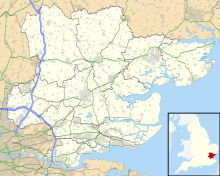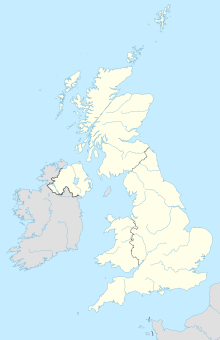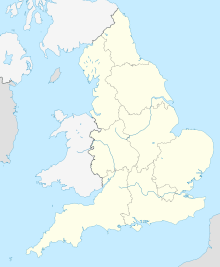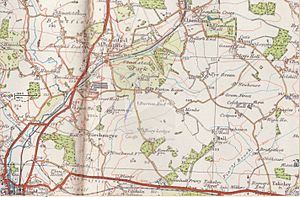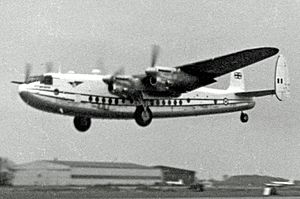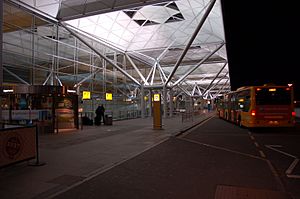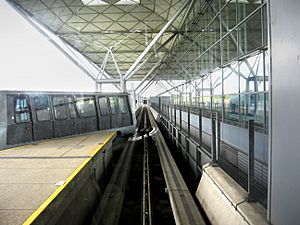London Stansted Airport facts for kids
Quick facts for kids
London Stansted Airport
|
|||||||||||
|---|---|---|---|---|---|---|---|---|---|---|---|
 |
|||||||||||
 |
|||||||||||
| Summary | |||||||||||
| Airport type | Public | ||||||||||
| Owner/Operator | Manchester Airport Holdings | ||||||||||
| Serves | Greater London Urban Area | ||||||||||
| Location | Stansted Mountfitchet, Uttlesford, Essex, England, United Kingdom | ||||||||||
| Opened | 7 August 1943 | ||||||||||
| Elevation AMSL | 348 ft / 106 m | ||||||||||
| Coordinates | 51°53′06″N 0°14′06″E / 51.88500°N 0.23500°E | ||||||||||
| Map | |||||||||||
| Runway | |||||||||||
|
|||||||||||
| Statistics (2022) | |||||||||||
|
|||||||||||
London Stansted Airport (IATA: STN, ICAO: EGSS) is the tertiary international airport serving London, the capital of England and the United Kingdom. It is located near Stansted Mountfitchet, Uttlesford, Essex, 42 mi (68 km) northeast of Central London.
London Stansted serves over 160 destinations across Europe, Asia and Africa. Stansted is a base for a number of European low-cost carriers. This includes being the largest base for low-cost airline Ryanair, with over 100 destinations served by the airline. As of 2022[update], it is the fourth-busiest airport in the United Kingdom after Heathrow, Gatwick, and Manchester. During the COVID-19 pandemic in 2021, it ranked second in the country. Stansted's runway is also used by private companies such as the Harrods Aviation, Titan Airways, and XJet terminals, which are private ground handlers that are able to handle private flights, charter flights, and state visits.
Converted to civil use from RAF Stansted Mountfitchet in the late 1940s, Stansted was used by charter airlines. It came under British Airports Authority control in 1966. The privatised BAA sold Stansted in February 2013 to Manchester Airports Group as a result of a March 2009 ruling by the Competition Commission against BAA's monopoly position.
Contents
Overview
London Stansted Airport is located near the village of Stansted Mountfitchet. It has one main passenger terminal. Three passenger satellites have departure gates; one is connected to the main terminal by an air bridge and the other two by the Stansted Airport Transit System people mover.
The terminal building was designed by Foster and Partners with input from structural engineer Peter Rice, and features a "floating" roof, supported by a space frame of inverted-pyramid roof trusses, creating the impression of a stylised swan in flight. The base of each truss structure is a "utility pillar", which provides indirect uplighting illumination and is the location for air-conditioning, water, telecommunications, and electrical outlets. The layout of the airport was originally designed to provide an unobstructed flow for passengers to arrive at the short-stay car park, move through the check-in hall, and go through security and on to the departure gates, all on the same level.
From 1997 to 2007, Stansted had rapid expansion of passenger numbers on the back of the boom in low-cost air travel, peaking at 24 million passengers in the 12 months to October 2007, but passenger numbers declined in the next five years. Passenger totals later increased, and in 2016 recorded an annual increase of 8.0% to 24.3 million, and numbers have since continued to rise.
History
Second World War
The airfield opened in early July 1943 with a dedication ceremony for the Stansted Airfield with a parade of builders, the 825th Engineer Aviation Battalion EAB and the 850th Engineer Aviation Battalion EAB of the United States Army, along with a small group of the British Royal Engineers who offered to help and wanted to learn how to operate the heavy construction equipment. Stansted Mountfitchet Airport was used during the Second World War as RAF Stansted Mountfitchet by the Royal Air Force and the United States Army Air Forces as a bomber airfield and as a major maintenance depot. Although the official name was Stansted Mountfitchet, the base was known as simply Stansted in both written and spoken form.
The station was first allocated to the USAAF Eighth Air Force in August 1942 as a heavy-bomber airfield. As well as an operational bomber base, Stansted was also an Air Technical Services Command maintenance and supply depot concerned with major overhauls and modification of B-26s. After D-Day, these activities were transferred to France, but the base was still used as a supply storage area for the support of aircraft on the continent.
Postwar use
After the withdrawal of the Americans on 12 August 1945, Stansted was taken over by the Air Ministry and used by No. 263 Maintenance Unit, RAF, for storage purposes. In addition, between March 1946 and August 1947, Stansted was used for housing German prisoners of war.
In November 1946, the recently established British cargo airline, London Aero and Motor Services, equipped with ex-RAF Handley Page Halifaxes, moved into Stansted, using it as a base for its operations until it was wound up in July 1948.
The Ministry of Civil Aviation finally took control of Stansted in 1949 and the airport was then used as a base by several UK charter airlines. The US military returned in 1954 to extend the runway for a possible transfer to NATO. The transfer to NATO was never realised, however, and the airport continued in civil use, ending up under BAA control in 1966.
During the 1960s, '70s, and early '80s, the Fire Service Training School was based on the eastern side of the airfield under the auspices of the Ministry of Transport and Civil Aviation, now the Civil Aviation Authority. The school was responsible for the training of all aviation fire crews for British airfields, as well as those of many overseas countries.
Commercial operations and redevelopment
Beginning in 1966, after Stansted was placed under BAA control, the airport was used by holiday charter operators wishing to escape the higher costs associated with operating from Heathrow and Gatwick.
Stansted had been held in reserve as a third London airport since the 1950s. However, after a public inquiry at Chelmsford in 1966–67, the government set up the Roskill Commission to review the need afresh. The Commission for the Third London Airport (the "Roskill Commission") of 1968–71 did not include Stansted as one of its four short-listed sites and recommended that Cublington in Buckinghamshire should be developed as London's third airport. However, the Conservative government under Ted Heath agreed with a minority recommendation that a site at Foulness in the Thames Estuary, later renamed Maplin, should be developed, but in 1974, the incoming Labour government under Harold Wilson cancelled the Maplin project because of the economic situation.
Stansted was then considered as an option for long-term development in the Advisory Committee on Airports Policy and the Study Group on South East Airports and was selected from a short list of six by the Conservative government in December 1979. The proposal, for a new terminal associated with the existing runway and the safeguarding of land for a second runway, was considered at the Airports Inquiries of 1981–83. The Inspector's Report was published in 1984 and the decision, announced in a white paper in 1985, was to approve a plan to develop Stansted in two phases, involving both airfield and terminal improvements that would increase the airport's capacity to 15 million passengers per year, but to reject the second runway.
Foster + Partners terminal
The current terminal building was designed by architectural practice Foster + Partners, commissioned in 1991. As part of the development, a railway branch was built to the airport, and Stansted Airport railway station opened in 1991. Construction was undertaken by the John Laing company and took place between 1988 and 1991, costing £100 million. In 1990, it was awarded the European Union Prize for Contemporary Architecture / Mies van der Rohe Award. The building, recognised as a landmark work of high-tech architecture, was opened to the public in 1991.
As part of the project's development, in 1988 Norman Foster and British architectural artist Brian Clarke made several proposals for an integral artwork for the terminal building. The principal proposal would have seen the east and west elevations of the terminal clad in two sequences of traditionally mouth-blown, leaded stained glass, along the full 162-metre (531 ft) length of the building. However, for technical and security reasons, the artwork was not executed. In 1991, the British Airports Authority commissioned a second, smaller stained glass project from Clarke for Stansted Airport in place of the 1988 proposal. The artist designed two stained glass friezes and a 6-metre (20 ft) high tower of stained glass for a circulation area in the centre of the terminal which, in their composition, echoed elements of Foster's structure; by 1994 the tower had been removed to 'allow greater flow of traffic through the space', and later the friezes were likewise removed.
Recent expansions
A major expansion programme to the existing terminal took place between 2007 and 2009, adding nearly 5,900 m2 (64,000 sq ft) of floorspace to give space for additional baggage carousels, a new immigration and passport control hall, and a hypostyle arrivals' hall with improved facilities.
In November 2006, Uttlesford District Council rejected a BAA planning application to increase the permitted number of aircraft movements and to remove the limit on passenger numbers. BAA immediately appealed against the decision and a public inquiry opened, lasting from May until October 2007. Planning Inspector Alan Boyland made his recommendations in January 2008. Those recommendations were largely followed by the Secretary of State for Transport (Geoff Hoon) and the Secretary of State for Communities and Local Government (Hazel Blears), who jointly allowed the applicant's appeal in October 2008. A legal challenge by community campaign group Stop Stansted Expansion was rejected by the High Court in March 2009.
In 2008, 57 people were arrested after Plane Stupid, an environmental activist group, broke through the barriers and created a "stockade" on a taxiway, which resulted in 52 flights being cancelled.
The Competition Commission ruled in March 2009 that BAA should sell Gatwick and Stansted Airports within two years. The ruling was quashed within a year following an appeal, but was subsequently upheld. The Competition Commission reconfirmed its ruling in July 2011 that the airport be sold, and the Court of Appeal turned down an appeal by BAA on 26 July 2012. In light of the result, BAA chose not to appeal to the Supreme Court of the United Kingdom and confirmed on 20 August 2012 that the airport would be sold.
In 2017, Antonov Airlines opened a UK office at Stansted for cargo charter flights, generally of outsize loads.
In March 2018, a group of activists delayed a deportation flight to Nigeria. 15 of the protestors were found guilty of "intentional disruption of services at an aerodrome", under the Aviation and Maritime Security Act 1990. This verdict on the Stansted 15 was described in New Statesman as having a chilling effect on public dissent.
Infrastructure
Terminal and satellite buildings
The terminal is separated into three areas: Check-in and main concourse along the front, Departures towards the back left, and Arrivals on the back right upon entry. No gates are in the main terminal building; instead, they are located in three separate oblong satellite buildings. The airport has 68 gates: 40 jetbridge gates, and 28 hardstands with six additional spaces for narrow-body planes to be stored; these spaces however inhibit the two spaces these storage spaces are flanked by.
As of 2013, Satellite One had also been redeveloped with the aim to attract more long-haul airlines to Stansted. Furthermore, dual jetbridges were added at stand 13, allowing faster boarding and deboarding of the aircraft. An additional building, known as the Advanced Passenger Vehicle (APV), was brought back into use in 2016 for flights departing during the busy 06:00 to 08:00 period. The APV building is linked to the main terminal building by an accessible route and acts as a bus terminal for international flights at remote stands. Prior to the completion of Satellite 3, this terminal (then consisted of gates 90–95) was in regular passenger use.
| Satellite Building | Gate Numbers | Passenger access | Notes |
|---|---|---|---|
| Satellite 1 | 1–19 | Transit system | Used by most major airlines such as British Airways, Emirates, Pegasus, TUI and Jet2. This area is not used by Ryanair and EasyJet, furthest in distance but first stop on transit from the main terminal. Around four minutes train ride – this terminal has jetbridges |
| Satellite 2 | 20–39 | Transit system | Used by AJet, Play, Ryanair and occasionally EasyJet. Situated in the upper level of Satellite 2 accessed via the second stop on transit from the main terminal. Jetbridges must be accessed by stairs one floor down (same level as gates 81–88). Around seven minutes train ride. |
| 81–88 | Walkway from main terminal | Used by EasyJet but may be used for Ryanair international and domestic departures; provides exit route for UK arrivals. International arriving passengers and those from the Common Travel Area are transferred to the international arrivals hall by bus. Located below gates 20–39, and only takes up half of the first floor, but parallel to the jetbridges, which are also used by gates 20–39. Around ten minutes walk from the terminal. | |
| Satellite 3 | 40–59 | Walkway from main terminal | Used exclusively by Ryanair; this building is not equipped with jet bridges. Around 15 minutes walk from the main terminal. |
| APV | 90–93 | Walkway from main terminal | Used by Ryanair during peak times; acts as a terminal for buses to remote stands. The access to the gates is underneath the main terminal, next to the quiet zone. Around a four minute walk from the main passenger area. |
Domestic arrivals (from the UK) use a separate exit route, located at the opposite end of the Terminal to the International arrivals hall. This exit is connected solely by footbridge from Satellite 2 gates 81–88. When a domestic flight arrives at a gate which is not located in Satellite 2, passengers are transported to a gate on Satellite 2 by a courtesy bus service from the aircraft.
Common Travel Area arrivals are coached from stand, and taken to an separate entrance located at the North East of the terminal which leads to the main terminal baggage reclaim belts, bypassing Border Force, but without bypassing Customs.
Car parks and hotels
Stansted has a variety of car parking including long-, mid-, and short-stay options along with valet and meet-and-greet parking services. Two drop off areas also are available. The express area is located near the short-stay car park, while a free service is within the mid-stay area. A fee is charged for the express service. Terminal Road North and its free drop-off area directly outside the terminal was closed shortly after MAG took over the airport in 2013.
Since 2004, Stansted also offers a range of hotel accommodation including Holiday Inn Express, Novotel, Premier Inn, and Radisson Blu hotels and the recently opened Hampton by Hilton, the last two of which are both within two minutes of the terminal building via an undercover walkway. Regular bus service handles transfers between the terminal building and Stansted's car parks and hotels.
Control tower
Stansted's air traffic control tower was completed in 1996 and was the tallest in Britain at the time of its construction. It is located on the southside of the airfield alongside the main terminal building. It replaced the old control tower, which offered poor views of the airfield once the current terminal building was opened in 1991.
Other infrastructure
There are several cargo buildings and hangars around the airfield. The main cargo centre is located by the control tower and handles most cargo operations, including aircraft such as the McDonnell Douglas MD-11 and the Boeing 747. There are a small number of hangars on the other side of the runway to the rest of the airport. The largest are located at the south east of the airfield, one of which is used by Ryanair.
Titan Airways has its head office in the Enterprise House on the airport property. Several airlines at one time had their head offices on the airport property. AirUK (later KLM uk) had its head office in the Stansted House. When Buzz existed, its head office was in the Endeavour House. When AB Airlines existed, its head office was in the Enterprise House. For a period Lloyd International Airways had its head office at the Lloyd House at Stansted. When Go Fly existed its head office was at the Enterprise House.
Proposed developments
Abandoned plans for a second runway
On 11 March 2008, BAA submitted a planning application (titled "G2") to expand the airport by 3 sq mi (8 km2) and for the construction of a second runway and terminal, etc., in line with a recommendation in the 2003 Air Transport White Paper (ATWP). This would have been the subject of a public inquiry, and if approved, would have allowed Stansted to handle more passengers than Heathrow did at the time of the application.
In May 2010, BAA withdrew its plans to build a second runway at Stansted and withdrew the plans to build a new runway at Heathrow.
The ATWP had anticipated that a second runway would be operational by 2011, but this date continued to slip. BAA's 2008 planning application envisaged operation commencing in 2015, and in 2009, BAA revised the anticipated opening date to 2017.
Prior to the United Kingdom's May 2010 general election, all three major political parties pledged not to approve a second runway. Soon after the election, the new government confirmed this, and BAA withdrew its application for planning permission, having spent nearly £200 million preparing for the public inquiry and buying up properties.
The public inquiry into BAA's second runway application had been scheduled to start on 15 April 2009, but the start was delayed by Secretary of State Hazel Blears to allow time for BAA and the government to consider the implications of the March 2009 Competition Commission's ruling that BAA must sell Stansted within two years. As 2011 drew to a close, BAA was still appealing against the Competition Commission ruling. On 20 August 2012, after losing a case at the Court of Appeal, BAA agreed to cease challenging the Competition Commission's ruling and to sell Stansted.
On 10 February 2010, Secretary of State John Denham, in an open letter, concluded that the inquiry could not reasonably start until after the general election. In addition, he commented that the planning application documents were nearly two years old and would require updating. Eventually, BAA realised the futility of pursuing its G2 application in the context of the new government policy and withdrew it on 24 May 2010.
Stop Stansted Expansion
The advocacy group Stop Stansted Expansion (SSE) was formed in 2002, as a working group of the North West Essex and East Herts Preservation Association, in response to the Government's consultation on expanding UK airports and, particularly, expansion plans for Stansted Airport subsequently defined in the Air Transport white paper in December 2003. In September 2012, as a result of pressure from the aviation industry, the government set up the Airports Commission, chaired by Sir Howard Davies, to consider what, if anything, needed to be done to maintain the UK's status as a global aviation hub. The commission concluded that an additional runway would be required for South East England and that it should be added to either Heathrow or Gatwick. Following the 2015 election, the commission made a final recommendation to expand Heathrow subject to certain environmental constraints.
Terminal redevelopment
MAG announced on 20 June 2013 as part of a visit to the airport by the Secretary of State for Transport that it would be launching an £80 million terminal redevelopment programme. MAG has invested £40 million and the remainder was invested by other commercial partners. The redevelopment included relocation of the security area, doubling the amount of seating, and improving the information displays. The new Departure Lounge offers a food court, new shops, and an Escape Lounge.
New arrivals terminal
There are proposals for an arrivals terminal to be built at Stansted. The site is planned to include larger immigration and baggage reclaim areas, with more shops and facilities available after arrival into the UK. The original plans were for the current terminal to be reconfigured to departures only, with security and check-in areas due to be expanded with an expected cost of £130m, and, once completed, will make London Stansted the only airport in the UK with dedicated arrivals and departures terminal buildings. Initial construction was due to start in 2018, taking three years to complete. However, the arrivals terminal was put on hold at the end of 2019. In 2020, an initial decision by Uttlesford District Council refused permission for a modified version of the plan. However, this decision was overturned by the Planning Inspectorate following a public inquiry in 2021 and permission has now been granted for the airports expansion plan.
As of 2023, the arrivals terminal has been deferred to a subsequent phase of development, expected between 2028-2031, following revised plans to extend the existing Terminal building.
Terminal extension
There are new plans to extend the existing Norman Foster designed Terminal building with a "three-bay" extension to the rear. The terminal extension will provide a more spacious departure lounge with a wide variety of shops, bars and restaurants, an expanded immigration hall and additional baggage reclaim belts. The scheme will also see the security hall extended and the latest check-in technology introduced.
As part of the redevelopment project, it is planned to demolish the passenger transit system and replace it with new ‘skylinks’ which connect the satellites to the terminal building.
Airlines and destinations
Passenger
The following airlines operate regular scheduled flights to and from Stansted Airport:
| Airlines | Destinations |
|---|---|
| AJet | Ankara, Istanbul–Sabiha Gökçen Seasonal: Antalya |
| Aurigny | Guernsey
|
| British Airways | Amsterdam (begins 15 December 2024), Florence Seasonal: Ibiza, Nice, Split (begins 7 September 2024) Seasonal charter: Calvi |
| Corendon Airlines | Seasonal: Antalya, Izmir (begins 15 May 2025)
|
| easyJet | Amsterdam, Belfast–International, Edinburgh, Glasgow Seasonal: Geneva, Zurich |
| Emirates | Dubai–International
|
| FlyOne | Chișinău
|
| HiSky | Chișinău, Oradea (begins 15 October 2024)
|
| Jet2.com | Agadir (begins 3 October 2024), Alicante, Antalya, Faro, Fuerteventura, Funchal, Gran Canaria, Lanzarote, Málaga, Marrakesh (begins 4 October 2024), Palma de Mallorca, Paphos, Rome–Fiumicino, Tenerife–South Seasonal: Athens, Bergen (begins 28 April 2025), Bodrum, Burgas, Catania, Chambéry, Chania, Corfu, Dalaman, Dubrovnik, Geneva, Girona, Grenoble, Heraklion, Ibiza, Izmir, Kalamata, Kefalonia, Kos, Larnaca, Malta, Menorca, Mytilene, Naples, Nice, Olbia, Prague, Preveza/Lefkada, Pula (begins 3 May 2025), Reus, Reykjavík–Keflavík, Rhodes, Salzburg, Santorini, Skiathos, Split, Thessaloniki, Tivat, Verona, Vienna, Zakynthos |
| Pegasus Airlines | Ankara, Antalya, Istanbul–Sabiha Gökçen, İzmir |
| Play | Reykjavík–Keflavík
|
| Royal Jordanian | Amman–Queen Alia
|
| Ryanair | Aalborg, Aarhus, Agadir, Alicante, Ancona, Asturias, Athens, Barcelona, Bari, Basel/Mulhouse, Belfast–International, Bergamo, Bergerac, Berlin, Biarritz, Billund, Bologna, Bordeaux (ends 24 October 2024), Bratislava, Bremen, Brindisi, Brno, Bucharest–Otopeni, Budapest, Bydgoszcz, Cagliari, Carcassonne, Castellón, Catania, Cluj-Napoca, Cologne/Bonn, Copenhagen, Cork, Dortmund, Dublin, Dubrovnik, Edinburgh, Eindhoven, Essaouira, Faro, Fez, Fuerteventura, Funchal, Gdańsk, Genoa, Girona, Gothenburg, Gran Canaria, Hahn, Hamburg, Helsinki, Karlsruhe/Baden-Baden, Katowice, Kaunas, Kerry, Klagenfurt, Knock, Košice, Kraków, Lamezia Terme, Lanzarote, La Rochelle, Leipzig/Halle, Limoges, Linz (begins 28 October 2024), Lisbon, Łódź, Lourdes, Luxembourg, Madrid, Málaga, Malta, Marrakesh, Marseille, Memmingen, Milan–Malpensa, Murcia, Nantes, Naples, Newquay, Nice, Nuremberg, Olsztyn-Mazury, Oslo, Ostrava, Ouarzazate, Palanga, Palermo, Palma de Mallorca, Paphos, Perugia, Pescara, Pisa, Plovdiv, Podgorica, Poitiers, Poprad–Tatry, Porto, Poznań, Prague, Rabat, Reggio Calabria (begins 27 October 2024), Riga, Rome–Ciampino, Rzeszów, Salzburg, Sandefjord, Santander, Santiago de Compostela, Sarajevo, Seville, Shannon, Sofia, Stockholm–Arlanda, Stockholm–Västerås, Szczecin, Tallinn, Tangier, Tenerife–South, Thessaloniki, Tirana, Toulouse, Tours, Trapani, Trieste, Turin, Valencia, Venice, Verona, Vienna, Vigo, Vilnius, Warsaw–Modlin, Wrocław, Zagreb, Zaragoza Seasonal: Alghero, Almería, Béziers, Brive, Chania, Corfu, Grenoble, Ibiza, Jerez de la Frontera, Kalamata, Kefalonia, Kos, Menorca, Nimes, Olbia, Örebro, Osijek, Perpignan, Ponta Delgada, Preveza/Lefkada, Pula, Reus, Rijeka, Rimini, Rhodes, Rodez, Rovaniemi, Salerno (begins 4 August 2024), Santorini, Zadar, Zakynthos |
| SunExpress | Antalya, Izmir Seasonal: Adana Dalaman (begins 5 April 2025), Gaziantep |
| TUI Airways | Gran Canaria, Sharm El Sheikh Seasonal: Chambéry, Corfu, Dalaman, Enfidha (begins 2 May 2025), Heraklion, Ibiza, Innsbruck, Kefalonia, Kittilä, Menorca, Palma de Mallorca, Paphos, Rhodes, Salzburg, Tenerife–South, Turin, Verona (begins 21 December 2024), Zakynthos |
Cargo
| Airlines | Destinations |
|---|---|
| Asiana Cargo | Almaty, Frankfurt, Seoul–Incheon
|
| Cargolux | Luxembourg
|
| China Southern Cargo | Guangzhou
|
| FedEx Express | Dublin, Frankfurt, Indianapolis, Memphis, Paris–Charles de Gaulle
|
| Qatar Airways Cargo | Doha
|
| Turkish Cargo | Istanbul
|
| UPS Airlines | Cologne/Bonn, Hong Kong, Louisville, Philadelphia, Newark |
Route development
Long-haul scheduled services commenced in 1987 with a short lived service from the Scottish airline Highland Express to Newark Liberty International Airport via Prestwick Airport. In the early 1990s American Airlines operated a transatlantic service between Stansted and Chicago–O'Hare, but the route was unprofitable and was withdrawn in 1993. Continental Airlines also operated services in the late 1990s from Newark Liberty International Airport, but this service was stopped shortly after the September 11 attacks in 2001.
Long-haul services to the United States returned in late 2005, when Eos Airlines and MAXjet Airways commenced all-business class services from Stansted to New York–JFK. In 2006, MAXjet expanded their service with flights to Washington–Dulles, Las Vegas, and Los Angeles. American Airlines began daily flights to Stansted in October 2007 from New York–JFK and was originally expected to operate a second daily flight from April 2008. However, because of the jump in fuel price, weakening economic performance, and worsening credit environment at the time, all three services to the United States have since been discontinued following the demise of MAXjet Airways in December 2007 and Eos Airlines in April 2008. Finally, in July 2008, American Airlines withdrew from Stansted, alongside its services to Gatwick, and consolidated all operations at Heathrow.
Long-haul transatlantic operations made a brief return to Stansted in June 2010, when Sun Country Airlines announced a seasonal weekly service from Stansted to Minneapolis/St. Paul. The flights made a refuelling stopover in Gander, Newfoundland and Labrador as the aircraft used for the flight, a Boeing 737-800, would not be able to complete a nonstop westbound flight from Stansted to Minneapolis. The flights operated from 11 June to 15 August 2010. In 2011, Sun Country operated to Gatwick rather than Stansted and then discontinued flights due to the price involved in carrying fuel on long-haul flights. . Long-haul services to Asia commenced in March 2009 with Malaysian low-cost airline AirAsia X providing direct flights to Kuala Lumpur International Airport; however, on 24 October 2011, this service moved to Gatwick Airport before being later withdrawn completely. Low-cost airline Primera Air launched non-stop flights from Stansted to Boston, Newark and Washington–Dulles, until the collapse of the airline meant the discontinuation of the routes by 2018, leaving Stansted without transatlantic routes once more. In 2019, Emirates began operating daily flights to its hub at Dubai-International using its Boeing 777-300ER aircraft. The route expanded to twice daily in mid-2023.
The COVID-19 pandemic negatively impacted the aviation industry, with Stansted Airport not being immune from the fallout. Ural Airlines (to Moscow–Domodedovo), Scandinavian Airlines (to Copenhagen), Aurigny (to Guernsey), Air India (to Amritsar and Mumbai), Air Senegal (to Dakar–Diass) and El Al (to Tel Aviv), which were scheduled to begin in 2020, never began operation. Additionally, easyJet, one of the largest operators at the airport at the time, announced the closure of their base at Stansted, which had more than two dozen routes and existed for more than a decade, in August 2020.
Statistics
Development
In 1988, over 1.1 million passengers passed through Stansted, the first time annual passenger numbers had exceeded 1 million at the airport. Consistent year-on-year growth followed, and by 1997, the total had reached over 5 million, rapidly rising to almost 12 million in 2000.
In 2007, passenger numbers peaked at nearly 24 million, but then declined for five years, and in 2012, the total was around 17.5 million. An increase of 2.2% was recorded in 2013 to 17.8 million passengers, then 11.7% in 2014 to 19.9 million, followed by 12.8% in 2015 to 22.5 million, and 8.0% in 2016 to a record total of 24.3 million, making Stansted the fourth-busiest airport in the United Kingdom. Stansted also is a major freight airport, the third-busiest in the UK during 2016, behind London Heathrow and East Midlands Airport, handling in excess of 223,203 tonnes per annum, although freight throughput has declined slightly from its 2005 peak level.
Passenger numbers for the year ending September 2016 increased by 8.4% to over 24 million for the first time since 2007.
Traffic figures
| Year | Number of passengers |
Percentage change |
Number of movements |
Freight (tonnes) |
|---|---|---|---|---|
| 2000 | 11,878,190 | – | 165,779 | 167,823 |
| 2001 | 13,665,333 | 169,583 | 165,660 | |
| 2002 | 16,054,522 | 170,544 | 184,449 | |
| 2003 | 18,722,112 | 186,475 | 198,565 | |
| 2004 | 20,910,842 | 192,245 | 225,772 | |
| 2005 | 21,998,673 | 193,511 | 237,045 | |
| 2006 | 23,687,013 | 206,693 | 224,312 | |
| 2007 | 23,779,697 | 208,462 | 203,747 | |
| 2008 | 22,360,364 | 193,282 | 197,738 | |
| 2009 | 19,957,077 | 167,817 | 182,810 | |
| 2010 | 18,573,592 | 155,140 | 202,238 | |
| 2011 | 18,052,843 | 148,317 | 202,593 | |
| 2012 | 17,472,699 | 143,511 | 214,160 | |
| 2013 | 17,852,393 | 146,324 | 211,952 | |
| 2014 | 19,941,593 | 157,117 | 204,725 | |
| 2015 | 22,519,178 | 168,629 | 207,996 | |
| 2016 | 24,320,071 | 180,430 | 223,203 | |
| 2017 | 25,902,618 | 189,919 | 236,892 | |
| 2018 | 27,996,116 | 201,614 | 226,128 | |
| 2019 | 28,139,051 | 199,925 | 224,139 | |
| 2020 | 7,536,869 | 86,107 | 254,573 | |
| 2021 | 7,145,802 | 93,316 | 263,631 | |
| 2022 | 23,289,652 | 159,502 | ||
| Source: UK Civil Aviation Authority |
||||
Busiest routes
| Rank | Airport | Total passengers |
Change 2021 / 22 |
|---|---|---|---|
| 1 | Dublin | 815,761 | |
| 2 | Istanbul–Sabiha Gökçen | 726,387 | |
| 3 | Budapest | 479,766 | |
| 4 | Rome–Ciampino | 470,293 | |
| 5 | Tenerife–South | 451,476 | |
| 6 | Bergamo | 441,375 | |
| 7 | Lisbon | 436,069 | |
| 8 | Barcelona | 435,732 | |
| 9 | Palma de Mallorca | 387,592 | |
| 10 | Faro | 380,778 | |
| 11 | Alicante | 372,451 | |
| 12 | Madrid | 370,521 | |
| 13 | Bucharest | 364,025 | |
| 14 | Málaga | 341,438 | |
| 15 | Porto | 337,183 | |
| 16 | Warsaw–Modlin | 322,116 | |
| 17 | Antalya | 320,545 | |
| 18 | Berlin | 319,487 | |
| 19 | Eindhoven | 308,211 | |
| 20 | Milan–Malpensa | 300,009 |
Ground transport
Transit system
The Stansted Airport Transit System connects the terminal to the satellite buildings via a 2 mi (3 km) free automated people mover service, which runs on dual concrete tracks. The system uses a mix of Adtranz C-100 and CX-100 vehicles to carry passengers to departure gates. Unlike the similar Gatwick Airport Shuttle Transit, the Stansted transit is only accessible "airside" (i.e. only after passengers pass through security). As part of the airport expansion plans, it is planned to demolish the Transit System in spring 2026 to make way for an expanded terminal. The transit will be replaced with pedestrian bridges.
Trains
Stansted Airport railway station is situated in the terminal building directly below the main concourse.
Services to London are on the Stansted Express train to and from London Liverpool Street in Central London. This service operates every 15 minutes and the usual journey time is between 45 and 53 minutes. Liverpool Street is served by the Central, Circle, Hammersmith & City and Metropolitan lines of the London Underground network, alongside the Elizabeth line, offering access throughout London. The Stansted Express also calls at Tottenham Hale, for the Underground's Victoria line and connections to various destinations in North London and the West End. Some Stansted Express services also call at Stansted Mountfitchet, Bishop's Stortford and/or Harlow Town en route to London Liverpool Street.
CrossCountry operates an hourly service from the airport to Birmingham New Street, via Cambridge, Peterborough and Leicester. Greater Anglia operates services to Norwich via Cambridge.
Buses and coaches
Scheduled express bus or coach services which run to and from London are provided by National Express and Airport Bus Express. The bus station is next to the terminal building.
Airport Bus Express operates service A21 to and from Liverpool Street Station via Stratford. National Express operates nearly 200 round trips a day and runs services A6 to Paddington Station typically every 30 minutes and taking 100 minutes (via Golders Green, Finchley Road, St. John's Wood, Baker Street and Marble Arch), A7 to Victoria Coach Station typically every 30 minutes and taking 115 minutes (via Bow, Mile End, Whitechapel, Southwark, and Waterloo), A8 to King's Cross Station typically every 30 minutes and taking 115 minutes (via Tottenham Hale, Shoreditch and Liverpool Street) and A9 non-stop to Stratford typically 2-3 times an hour and taking 50 minutes.
National Express also runs direct coach services to the airport from Luton Airport and Heathrow, and additionally from Birmingham (11 a day), Oxford (8 a day), Norwich (10 a day), and Cambridge (11 a day).
Stansted is also the start of the Essex Airlink X30 coach service to Southend-on-Sea via Chelmsford and London Southend Airport, the X20 coach service to Colchester via Braintree and the X10 coach service to Basildon via Chelmsford, all operated hourly by First Essex.
Local bus services operate to nearby communities, including the 510/509/508 (Harlow to Stansted via Stansted Mountfitchet, Parsonage Lane and Takeley, respectively), 7/7a (Bishops Stortford to Stansted), 133 (Braintree), and 6 (Saffron Walden), operated by Arriva.
Roads
Stansted is connected to northeast London and Cambridge by the M11 motorway and to Braintree, Colchester, and Harwich by the A120, which is dual-carriageway until Braintree. The road distance to London is 37 miles (60 km).
As of October 1996, the airport has 2,500 short-stay parking spaces within walking distance to the terminal. In addition, as of the same month, the airport has over 8,000 long-stay spaces located near the M11 motorway and A120 junction. A courtesy bus service links the long-stay spaces to the terminal. The airport also offers mid-stay parking, closer to the terminal than its long-stay spaces. Stansted Airport also offers valet parking and a meet-and-greet service, which is similar to valet, but marketed more at the leisure-traveller market, both are run from the short-stay car park.
Incidents and accidents
Stansted has been designated by the UK government as its preferred airport for any hijacked planes requesting to land in the UK. This is because its design allows a hijacked airliner to be isolated well away from any terminal buildings or runways, allowing the airport to continue to operate while negotiations are carried out, or even while an assault or rescue mission is undertaken. For this reason, Stansted has been involved in more hijack incidents than might be expected for an airport of its size.
- On 30 April 1956, a Scottish Airlines Avro 685 York C.1 suffered a runway excursion during a rejected takeoff, winding up in a drain on the side of the runway, collapsing the undercarriage. Two passengers died out of 54 on board.
- On 23 December 1957, a Scottish Airlines Avro 685 York C.1, a cargo flight, crashed on its third approach to Stansted striking a tree 3/4 of a mile short of the runway, crashing in flames. All 4 occupants died.
- On 27 February 1982, an Air Tanzania Boeing 737-2R8C landed at the airport after having been hijacked on an internal flight from Mwanza to Dar es Salaam and flown to the UK via Nairobi, Jeddah, and Athens, where two passengers had been released. The hijackers demanded to speak to exiled Tanzanian opposition politician Oscar Kambona. This request was granted, and after 26 hours on the ground, the hijackers surrendered and the passengers were released.
- On 30 March 1998, an Emerald Airways Hawker Siddeley HS 748 carrying the Leeds United F.C. was brought down immediately after takeoff when its starboard engine exploded. Forty passengers were onboard (18 from the Leeds team). Only two passengers were injured.
- On 22 December 1999, Korean Air Cargo Flight 8509, a Boeing 747-200F, crashed shortly after take-off from the airfield due to pilot error. The only people on board at the time were the aircrew, and all four were killed. The aircraft crashed in Hatfield Forest near the village of Great Hallingbury.
- On 6 February 2000, an Ariana Afghan Airlines Boeing 727 with 156 people on board was hijacked and flown – stopping at Tashkent, Kazakhstan, and Moscow – to Stansted Airport. After a four-day stand-off, the hostages on board were safely freed and the incident ended peacefully. The motive behind the hijack was to gain asylum in the UK, sparking another debate about immigration into the country. A large number of passengers on board the plane also applied for asylum. The remainder returned to Afghanistan. Nine hijackers were jailed, but their convictions for hijacking were quashed for misdirection of the jury in 2003, and in July 2004, a court ruled that they could not be deported from the UK.
- On 24 May 2013, Pakistan International Airlines Flight 709 from Lahore, Pakistan, was escorted by RAF Typhoons after being diverted from Manchester Airport due to an onboard threat. Two men were charged with endangering an aircraft.
- On 21 September 2013, SriLankan Airlines Flight UL503 inbound to Heathrow was escorted by RAF Typhoons to Stansted Airport after being diverted. Two men were detained for endangering an aircraft, one was formally arrested.
See also
 In Spanish: Aeropuerto de Londres-Stansted para niños
In Spanish: Aeropuerto de Londres-Stansted para niños


